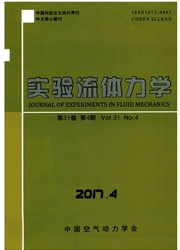

 中文摘要:
中文摘要:
在北航的风洞中进行了双立尾一三角翼布局的立尾抖振实验,目的是研究立尾抖振产生的原因。主要采用了激光测振仪测立尾加速度和动态压力传感器测立尾表面的动态压力的实验方法。实验结果表明在旋涡破裂以后,立尾上就会产生强烈的抖振。抖振是由立尾上表面压力的周期性脉动造成的。对机翼和立尾表面的压力频谱分析表明,立尾上的压力脉动来源于机翼前旋涡破裂流中的螺旋波。对于本实验使用的模型来说,当机翼迎角α=0°-20°范围,由于流动是附着流和涡流,所以立尾没有明显抖振;当机翼迎角在α=20°-56°范围,立尾处在破裂涡流的范围,立尾抖振明显,并且抖振强度在35°-50°之间达到最大。因此,三角翼破裂涡流中的螺旋波正是双立尾产生抖振的主要原因。
 英文摘要:
英文摘要:
Experiments of a configuration with twin vertical tails/delta wing have been carried out in a wind tunnel of BUAA in order to understand the source of vertical tail buffeting. A laser device and dynamic pressure sensor were used to measure acceleration of the tip of the vertical tail and dynamic pressure on the surface of vertical tail . It has been shown that intensive buffeting of the vertical tail happens after leading edge vortices over the wing are broken down. Buffeting is caused due to the periodic pressure fluctuation acting on the surface of the tail. It has also been demonstrated by the spectral analysis that the periodic pressure fluctuation is original from the spiral wave which is found in the breakdown vortex flow over the wing and vertical tails. For the tested model, at angles of attack ranging from 0° to 20° there is no obvious buffeting of the vertical tail because flow is attached or vortex flow; at angles of attack ranging from 20° to 56° there is obvious buffeting of vertical tail because vertical tails are located at the breakdown vortex flow; at angle of attack ranging from 35° to 50° intensity of buffeting reaches the maximum. So the spiral wave of the breakdown vortex flow over the wing is the primary cause exciting vertical tail buffeting.
 同期刊论文项目
同期刊论文项目
 同项目期刊论文
同项目期刊论文
 期刊信息
期刊信息
